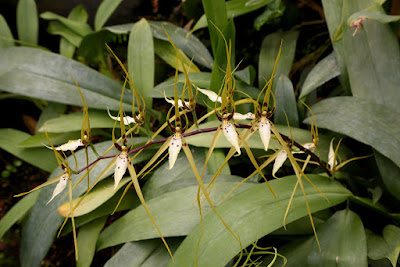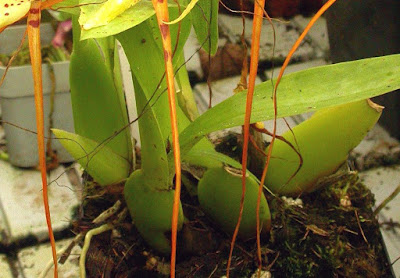Brassia arcuigera orchid is native to Nicaragua, Costa Rica, Panama, Venezuela, Colombia, Ecuador and Peru on both sides of the Andes. In Costa Rica, there are numerous places of occurrence in the provinces of Alajuela and Guanacaste in the isthmus from the Pacific. In the province of Alajuela, the plants grow almost from sea level to 960 m. In the province of Guanacaste they were found at heights from 600 to 1200 m. In Panama, plants grow on the Pacific side of the isthmus in the provinces of Coclé and Veraguas at an altitude of 910-1040 m and northeast from Panama city in the province of Panama at an altitude of 800-1200 m.
Brassia arcuigera orchid, also called as The Arching Brassia, is a species of the genus Brassia. Several synonyms are know for this species such as: "Brassia antherotes Rchb. f. 1879"; "Brassia antherotes var. longissima (Rchb.f.) Teusch. 1961"; "Brassia hinksoniana H.G. Jones 1974"; "Brassia lawrenceana Lindley var. longissima Rchb.f 1868"; "Brassia longissima [Rchb.f]Schlechter Nash 1914"; "Brassia longissima (Rchb. f.) Schltr. in part 1914". Brassia arcuigera was first described by Heinrich Gustav Reichenbach in 1869.
IDENTIFY BRASSIA ARCUIGERA ORCHID
Brassia arcuigera orchid is native to Nicaragua, Costa Rica, Panama, Venezuela, Colombia, Ecuador and Peru on both sides of the Andes. In Costa Rica, there are numerous places of occurrence in the provinces of Alajuela and Guanacaste in the isthmus from the Pacific. In the province of Alajuela, the plants grow almost from sea level to 960 m. In the province of Guanacaste they were found at heights from 600 to 1200 m. In Panama, plants grow on the Pacific side of the isthmus in the provinces of Coclé and Veraguas at an altitude of 910-1040 m and northeast from Panama city in the province of Panama at an altitude of 800-1200 m. In Ecuador, plants are found on the west slopes of the Andes in the provinces of Canar, Chimborazo, Cotopaxi, Napo and Pichincha at an altitude of 500-1000 m. Plants usually grow on trees covered with moss in tropical forests mountainous or damp, lower-lying rain forests. In Venezuela, this orchid is found between Duaca and Agua Fría. In Colombia they grow at heights from 1000 to 1800 m above sea level.
It is a unifoliate, large sized, hot to cool growing, epiphytic, rarely terrestrial (on embankments) reaching 30-70 cm in height, with elliptic-oblong, strongly laterally compressed, ancipitous pseudobulbs. Pseudobulbs are 4-16 cm long and 2.5-4.0 cm wide. The elliptical-oval pseudobulbs are strongly flattened, with sharp edges and are partially surrounded at the base by several longitudinally folded, covering them as if paper covers, and on the top of the top a leaf-like plate grows. The increments are arranged relatively close together on a short rhizome, often forming small clumps.
The pseudobulbs subtended by 1 to 2 foliaceous sheaths with articulate, subcoriaceous, elliptic, conduplicate base leaves. The leaves have a length of 25-55 cm and a width of 4-7 cm. A single, longitudinal-lanceolate, leathery leaf grows from the top of each pseudobulb. The leaves are sharp at the apex and narrowed at the base, where they are longitudinally folded over a short distance, forming a short petiole.
The inflorescence is 25-45 cm long with the final bunch. The curved flower shoot grows at the base of the last mature pseudobulb along the top axis that maintains the leaf of the casing. The flowers are arranged bilaterally and opposite in the upper half of the flower shoot, creating symmetrical pairs. Each flower is facing the outside of the flower stalk and is mounted on a stiff stalked ovary, 1.5-3 cm long.
This plant blooms in the spring on a basal, lateral to pendulous, bracteate, 2' (60 cm) long, with 6-15 in every inflorescence. The flowers are very large, pleasantly fragrant, spider-shaped, with long, narrow, pointed ends and wide spread, rigid, stretched elements. The petals of both whorls are yellow to greenish-yellow or greenish-white when they are young, and with age they acquire an orange-yellow color. They are dotted or stained with a red-brown color at the base. The lip may be white or colored like the petals and has few red-brown spots at the base. The thickening at the base of the lip consists of a pair of raised white bulges with a yellow-orange, furry furrow between them. The flowers are up to 30 cm long from the top of the dorsal petal to the tips of the lateral outer petals, but they are only 7 cm wide between the upward facing petals of the inner whorl and may be up to 16 cm between the tips of the obliquely spread side flakes. The elevated, longitudinally-lanceolate ridge petal is 8-10 cm long and 0.4-0.5 cm wide at the base and tapers into a long, sharp tip. Narrow, longitudinally lanceolate, obliquely inclined side flakes are 10-18 cm long and 0.5-0.6 cm wide at the base and narrow gradually into a long, thin, pointed tip resembling a thread. Narrow, longitudinally lanceolate, pointed tips of the inner whorl, which extend diagonally upwards, are only 5-6 cm long and 0.4-0.6 cm wide at the base. They are slightly sickle-shaped, curving up and inwards along the length, sometimes to such an extent that their vertices cross the front of the dorsal leaf. The lip is simple, narrow-ovate to lanceolate, sharp-edged, with smooth edges and 5-6 cm long at 1.2-1.5 cm wide at the base. The thick, forward, cylindrical bracket is 0.7-0.9 cm long.
GROW AND CARE BRASSIA ARCUIGERA ORCHID
Flowering period given in climatic data is based on reports of breeders. In Costa Rica, these plants bloom in late winter and early spring. In Ecuador, flowering occurs from late summer to the end of winter.
Light:
About 20000-30000 lux. The conditions should be rather clear, but the plant does not need a direct midday sun. Always need to ensure good air circulation.
Temperature:
It is a plant with moderate thermal requirements. Throughout the year, the average daily temperature is about 23-27 ° С, the average night temperature is 17-19 ° С, the daily amplitude is 6-9 ° С. In nature in winter and early spring there are warmer days and cool nights, which gives a greater diurnal temperature drop.
Humidity:
About 80-85% for most of the year, in winter and early spring falls to about 70-75%. Higher humidity is recommended in summer.
Watering:
In natural conditions, precipitation is abundant throughout the year, with the exception of fairly dry winter months and early spring. The plant needs to be watered abundantly during a period of active growth, but it is necessary to ensure good drainage so that the substrate around the roots does not decompose and does not soak.
Fertilizer:
Plants need to fertilize a weekly 1/4 - 1/2 of the recommended dose of fertilizer for orchids. Fertilizer with a high content of nitrogen is useful to give from spring to mid-summer, and a fertilizer with a high content of phosphorus - in late summer and autumn.
Cultivate and growing medium:
Plants can be fixed tightly to pieces of tree fern or cork. However, if they are so grown, they should be provided with high humidity, and in the summer they must be watered at least once a day. In the period of extremely hot and dry weather, attached plants may require even several waterings during the day. Many people think that it is difficult to maintain humidity under such conditions, so often grow orchids in pots and baskets filled with a loose, rapidly drying substrate, for example, the roots of osmunda ferns or cut tree fern fibers, densely packed in a pot.
Rest period:
The temperature conditions described here should be observed throughout the year. In the natural environment in winter precipitation is quite small, but in rain forests their number is higher than indicated in the climatic tables. Abundant dew and fog give additional moisture. Cultivated plants require less water in winter after ripening new growths, but should not completely dry out or remain without water for a long time. Fertilizing should be reduced or eliminated before the appearance of new growths and the beginning of more abundant watering in the spring.
Repotting and dividing:
Repotting or dividing plants should be done when the growth of new roots begins. Transplanting at this stage allows the plants to acclimate in a relatively short time and provides them with the least stress.















COMMENTS